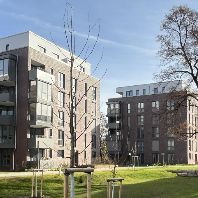What are the main changes in the logistics sector that you expect to define the market in the post-Covid world?
Logistics as an asset class has continued to evolve and expand. Logistics assets were historically considered more or less basic boxes built in six months, in most simplified terms. Today, there are all different shapes and sizes, from last-mile units with low site cover to multi-storey advanced e-commerce fulfilment centres. Ten years ago, 40,000m² was considered a large logistics centre, while today it’s 200,000m². Ceiling heights have also increased from standards of 8-10m to 18-20m and more. Much of this change has resulted from e-commerce demand and the fact that technology has shaped how space can be used efficiently. Similarly, several years ago rents generally were in the low to mid-single digits, while today we’ve seen rents that are higher than retail. We are also now witnessing occupiers invest meaningful amounts in employee amenities and well-being as well as recognising the environmental impact of the sector. These are all signs of positive and significant progress within the sector.
Are there any concerns that vaccination and return to normal will decrease projected demand for e-commerce activity and distribution centre demand?
I wouldn’t think so – the trend to order online is permanent. The next generation will expect online shopping of all products as the norm, including same-day or next-day delivery. The natural balance between online and bricks and mortar is trending towards a 50:50 ratio, though this will of course vary depending on the exact sector. Consider that in the UK, the most advanced e-commerce market in Europe, penetration is at around 35%, while most countries in Europe stand much lower, at around 10%. The pandemic has merely accelerated a trend that was already in play. What was expected to take ten years will now happen in two years or less. Today there is a real supply shortage of modern logistics stock in Europe, so you can only imagine how much more is needed to meet a 50:50 environment. Even if we end up where the UK is today, that’s still three times as much e-commerce sales in most countries which require a commensurate amount of real estate, especially in those regions with rapidly growing and urbanising populations.
What are the main challenges the investors are currently facing in the logistics market?
The weight of capital chasing industrial and logistics has resulted in a highly competitive market that has experienced unprecedented activity. It is not unheard of that in a region where yields for logistics assets never fell below 7% are suddenly achieving 5% or less. It is hard to comprehend that yields can compress 75bps in one quarter or rents can increase steadily 8% year-on-year. In many capital city locations, prime industrial yields are tighter than prime office. Add in geopolitical effects and material cost fluctuations which are other factors to consider. Is it reasonable to expect logistics rents to increase beyond retail? Can yields fall below 3%? Finding the best value opportunities is difficult, especially if you are constrained to a certain country, region or sector. Valuation uncertainty is another factor as that is usually backwards-looking, so what may be true open market value today, is not necessarily reflected in the financing you can achieve, another issue that requires a strategy adjustment. In the end, investors may have set return expectations that now do not make sense in the space. Adjusting to all of this, while at the same time trying to project what the sector will do over the next two to five years, is not the simplest task.
How can organizations create more sustainable supply chain operations?
Energy usage is a huge factor in real estate, both in construction and in use, directly and indirectly. Sustainable construction practices are important, including better use of materials – I’ve seen modern warehouses in Scandinavia with significant wood components for example. Rainwater recycling, heat pump systems to store energy in summer months, as well as solar power – now the world’s cheapest power source – and smart design all factor in reducing energy consumption, and the end result is a win-win situation for everyone. The strategic location of assets is key to reducing miles driven both by trucks and by employees. This can be further enhanced by providing good public transport connections or employee bus services, as well as the use of modern efficient electric vehicles. Every little bit helps in making our industry more sustainable and better for future generations, and I am glad to see these changes being made.
How did the ongoing pandemic reshape Blackbrook’s investment strategy?
The impact of the pandemic was unexpected, and everyone was learning day-to-day. When the first lockdowns began, and the extent of the economic impact was largely unknown, we chose to take our time and monitor the markets and pandemic development. It has been fantastic to witness the rapid progress made with vaccines, together with unprecedented government support for their people. When we felt that we were seeing the green shoots of a better environment, we determined that it would be a good time to actively pursue new investments, particularly, though not exclusively, targeting defensive sectors and those resilient to the impacts of e-commerce. From inception, we have had a long-term investment strategy, designed to ride through economic cycles. Our focus on mission-critical real estate with credit-worthy occupiers remains unchanged. Industrial & logistics which has seen tailwinds increase with onshoring of warehousing/production and rising e-commerce demand was always at the core of our strategy. I suppose what has had to adapt the most is our underwriting of logistics and industrial considering the aforementioned challenges – there are no opportunistic acquisitions in the sector (in the traditional sense), unlike what we will see in office, retail and hospitality. The platform we built over the past year has allowed us to move quickly and build an attractive portfolio of almost €500m across Europe despite the pandemic and the associated hurdles we face.















